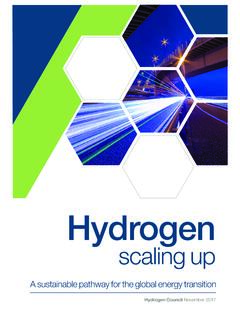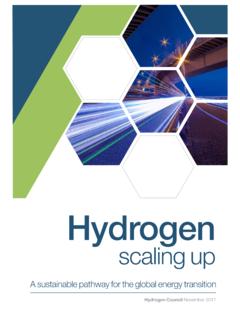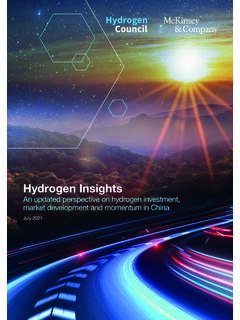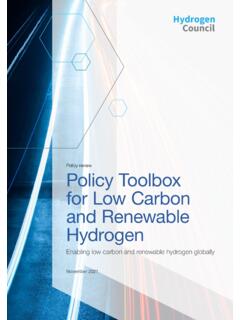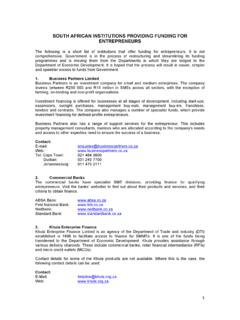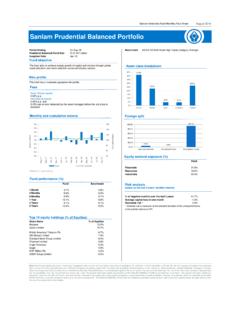Transcription of Hydrogen
1 A sustainable pathway for the global energy transitionHydrogen scaling upHydrogen Council November 2017 Published in November 2017 by the Hydrogen of this document are available upon request or can be downloaded from our website at report was authored by the Study Task Force of the Hydrogen Council, consisting of senior executives of 18 companies: Air Liquide , Alstom, Anglo American plc, Audi AG, BMW Group, Daimler AG, Engie , GM, Honda Motor Co. Ltd, Hyundai Motor Company, Iwatani Corporation, Kawasaki Heavy Industries Ltd.
2 , Plastic Omnium, Royal Dutch Shell, Statoil ASA, The Linde Group, Total , and Toyota Motor Corporation. The Hydrogen Council is composed of 18 steering members that authored the report and 10 supporting members: Mitsui & Co, Plug Power, Faber Industries, Faurecia, First Element Fuel (True Zero), Gore, Toyota Tsusho, Hydrogenics, Ballard, & Company provided analytical scaling upContentExecutive summary7 Methodology12 Our vision. The Hydrogen economy in is a central pillar of the energy transformation required to limit global warming to two degrees 16In all seven application areas, Hydrogen can offer economically viable and socially beneficial solutions 18 Achieving the Hydrogen vision would create significant benefits for the energy system, the environment, and businesses around the world 21 Getting there.
3 A roadmap to the Hydrogen Hydrogen and fuel cells are critical elements in the decarbonization of the transportation sector. 29 Industry energy. Hydrogen can provide decarbonized high-heat for industrial processes. 41 Building heat and power. Hydrogen can help decarbonize building heat a nd powe r. 45 Industry feedstock. Hydrogen as feedstock can be decarbonized and used to replace fossil feedstock. 51 Energy system. Hydrogen is a versatile energy carrier that can enable the renewable energy system. 57 What needs to be done.
4 A call to the Hydrogen economy would require annual investments of about $20 to 25 billion for a total of about $280 billion until 2030 66 Industry has to bring down costs of Hydrogen and applications through scale68To begin the journey, we propose large-scale deployment initiatives supported by long-term policy frameworks 71 Glossary75 Bibliography7667 Executive summaryThe Hydrogen Council is the largest industry-led effort to develop the Hydrogen economy. Launched in January 2017 at the World Economic Forum, its members include leading companies that invest along the Hydrogen value chain, including transportation, industry, and energy exploration, production, and members of the Council, we are convinced that Hydrogen can offer economically viable, financially attractive, and socially beneficial solutions.
5 Furthermore, in certain sectors and geographies it will be unavoidable to enable the energy transition and improve air quality in this report, we present the first comprehensive vision of the long-term potential of Hydrogen and a roadmap for deployment. This ambitious yet realistic approach would deliver deep decarbonization of transport, industry, and buildings, and enable a renewable energy production and distribution system. To realize this vision, investors, industry, and government will need to ramp up and coordinate their efforts.
6 Our vision: The Hydrogen economy in 2050 Hydrogen is a central pillar of the energy transformation required to limit global warming to two degrees Celsius. To achieve the two-degree scenario, the world will need to make dramatic changes year after year and decrease energy-related CO2 emissions by 60% until 20501 even as the population grows by more than 2 billion people2 and billions of citizens in emerging markets join the global middle class. Hydrogen can play seven major roles in this transformation: Enabling large-scale renewable energy integration and power generation Distributing energy across sectors and regions Acting as a buffer to increase energy system resilience Decarbonizing transportation Decarbonizing industrial energy use Helping to decarbonize building heat and power Providing clean feedstock for all seven application areas, Hydrogen can offer economically viable and socially beneficial solutions.
7 In our vision, Hydrogen enables the deployment of renewables by converting and storing more than 500 TWh of otherwise curtailed electricity. It allows international energy distribution, linking renewable-abundant regions with those requiring energy imports. It is also used as a buffer and strategic reserve for power. 1 From 34 Gt in 2015 to 26 Gt in 2030 and 13 Gt in 2050 (IEA, 2017) 2 From to billion people in 2050 (United Nations, 2017) Hydrogen scaling up 8 Hydrogen scaling up On the demand side, too, Hydrogen molecules are a critical complement to electrons in the challenge of far-reaching decarbonization.
8 Our vision sees Hydrogen powering more than 400 million cars, 15 to 20 million trucks, and around 5 million buses in 2050, which constitute on average 20 to 25% of their respective transportation segments. Since Hydrogen plays a stronger role in heavier and long-range segments, these 20% of the total fleet could contribute more than one-third of the total CO2 abatement required for the road transportation sector in the two-degree scenario. In our vision, Hydrogen also powers a quarter of passenger ships and a fifth of locomotives on non-electrified tracks, and Hydrogen -based synthetic fuel powers a share of airplanes and freight buildings, Hydrogen builds on the existing gas infrastructure and meets roughly 10% of global demand for heat.
9 In industry, Hydrogen is used for medium- and high-heat processes, for which electrification is not an efficient option. Current uses of Hydrogen as a feedstock are decarbonized through clean or green production pathways. In addition, Hydrogen is used as renewable feedstock in 30% of methanol and about 10% of steel this vision would create significant benefits for the energy system, the environment, and the global economy. Across all seven roles, Hydrogen could account for almost one-fifth of total final energy consumed by 2050.
10 This would reduce annual CO2 emissions by roughly 6 Gt compared to today s technologies, and contribute roughly 20% of the additional abatement required to limit global warming to two degrees Celsius (above and beyond already agreed commitments). It would also eliminate local emissions such as sulfur oxides, nitrogen oxides, and particulates linked to smog formation, and reduce noise pollution in cities. The transportation sector would consume 20 million fewer barrels of oil per day, and domestic energy security would rise significantly.
